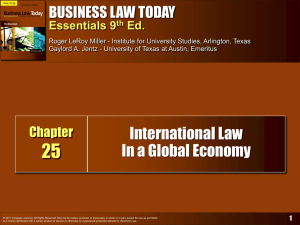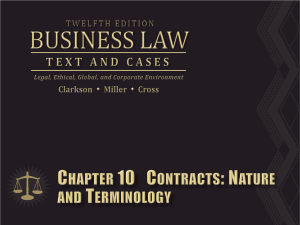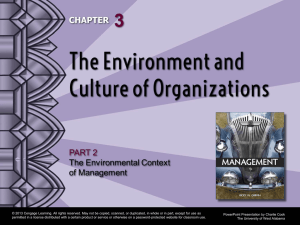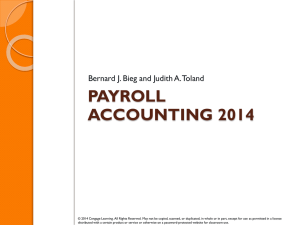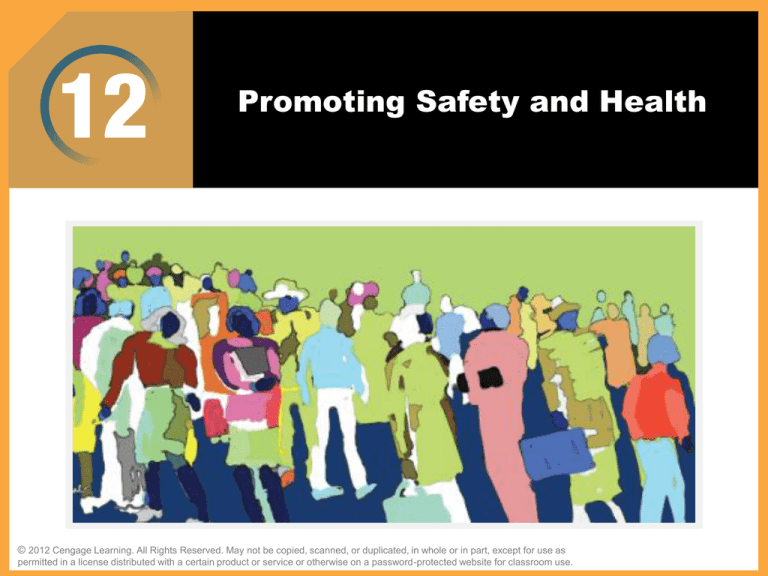
Promoting Safety and Health
The Challenges of Human Resources Management
© 2012 Cengage Learning. All Rights Reserved. May not be copied, scanned, or duplicated, in whole or in part, except for use as
permitted in a license distributed with a certain product or service or otherwise on a password-protected website for classroom use.
1–1
Chapter Objectives
After studying this chapter, you should be able to
LEARNING OUTCOME 1
LEARNING OUTCOME 2
LEARNING OUTCOME 3
LEARNING OUTCOME 4
LEARNING OUTCOME 5
Summarize the general provisions of the Occupational
Safety and Health Act (OSHA).
Describe the measures managers and employees can take
to create a safe work environment.
Identify ways to control and eliminate various on-the-job
health hazards.
Describe the programs organizations utilize to build better
health among their workforces.
Indicate the methods for coping with job stress.
© 2012
Learning.
All Rights
Reserved.
May not
be not
copied,
scanned,scanned,
or duplicated,
in whole or in
in whole
part, except
useexcept
as
©
2012Cengage
Cengage
Learning.
All Rights
Reserved.
May
be copied,
or duplicated,
or in for
part,
for use as
permitted
distributed
withwith
a certain
product
or service
or otherwise
on a password-protected
website for classroom
use.
permittedinina alicense
license
distributed
a certain
product
or service
or otherwise
on a password-protected
website for
classroom use.
2 of 38
36
Safety and Health: It’s the Law
• Consider these facts:
In 2009, 3.6 million private-sectors workers suffered
work-related injuries and illnesses.
Back injuries, most of which occur because of
improper lifting, are the nation’s no. 1 workplace safety
problem. More than 1 million workers suffer back
injuries each year.
Each year the cost of occupational injuries and
illnesses totals more than $156 billion.
In 2009, 4,340 employees died from work accidents.
Ninety percent of fatal work injuries involve workers in
private industry.
© 2012
Learning.
All Rights
Reserved.
May not
be not
copied,
scanned,scanned,
or duplicated,
in whole or in
in whole
part, except
useexcept
as
©
2012Cengage
Cengage
Learning.
All Rights
Reserved.
May
be copied,
or duplicated,
or in for
part,
for use as
permitted
distributed
withwith
a certain
product
or service
or otherwise
on a password-protected
website for classroom
use.
permittedinina alicense
license
distributed
a certain
product
or service
or otherwise
on a password-protected
website for
classroom use.
3 of 38
36
Occupational Safety and Health Act (OSHA)
of 1970
• General Provisions
To “assure the safety and health of America’s workers
by setting and enforcing standards; providing training,
outreach, and education; establishing partnerships;
and encouraging continual improvements in workplace
safety and health.”
• OSHA’s Coverage
All nongovernmental employers and employees; state
and local government employees
© 2012
Learning.
All Rights
Reserved.
May not
be not
copied,
scanned,scanned,
or duplicated,
in whole or in
in whole
part, except
useexcept
as
©
2012Cengage
Cengage
Learning.
All Rights
Reserved.
May
be copied,
or duplicated,
or in for
part,
for use as
permitted
distributed
withwith
a certain
product
or service
or otherwise
on a password-protected
website for classroom
use.
permittedinina alicense
license
distributed
a certain
product
or service
or otherwise
on a password-protected
website for
classroom use.
4 of 36
38
OSHA Provisions
• OSHA Standards
Apply to general industry, maritime, construction,
and agriculture
Cover the workplace, machinery and equipment,
material, power sources, processing, protective
clothing, first aid, and administrative requirements
• Enforcement of the Act
The Secretary of Labor is authorized by the Act to
conduct workplace inspections, to issue citations,
and to impose penalties on employers.
– Inspections are conducted by the Occupational Safety and
Health Administration of the Department of Labor.
© 2012
Learning.
All Rights
Reserved.
May not
be not
copied,
scanned,scanned,
or duplicated,
in whole or in
in whole
part, except
useexcept
as
©
2012Cengage
Cengage
Learning.
All Rights
Reserved.
May
be copied,
or duplicated,
or in for
part,
for use as
permitted
distributed
withwith
a certain
product
or service
or otherwise
on a password-protected
website for classroom
use.
permittedinina alicense
license
distributed
a certain
product
or service
or otherwise
on a password-protected
website for
classroom use.
5 of 38
36
Enforcing OSHA Standards
• Workplace inspections
• Citations and penalties
• On-site consultations
• Voluntary protection programs
• Training and education
© 2012
Learning.
All Rights
Reserved.
May not
be not
copied,
scanned,scanned,
or duplicated,
in whole or in
in whole
part, except
useexcept
as
©
2012Cengage
Cengage
Learning.
All Rights
Reserved.
May
be copied,
or duplicated,
or in for
part,
for use as
permitted
distributed
withwith
a certain
product
or service
or otherwise
on a password-protected
website for classroom
use.
permittedinina alicense
license
distributed
a certain
product
or service
or otherwise
on a password-protected
website for
classroom use.
6 of 36
38
OSHA’s System of Inspection Priorities
First
Level
Inspection of imminent danger situations
Second
Level
Investigation of catastrophes, fatalities, and accidents
that result in hospitalization of five or more employees
Third
Level
Investigation of valid employee complaints of alleged
violations of standards or of unsafe or unhealthful
working conditions
Fourth
Level
Special-emphasis inspections aimed at specific highhazard industries, occupations, or substances that are
injurious to health
© 2012
Learning.
All Rights
Reserved.
May not
be not
copied,
scanned,scanned,
or duplicated,
in whole or in
in whole
part, except
useexcept
as
©
2012Cengage
Cengage
Learning.
All Rights
Reserved.
May
be copied,
or duplicated,
or in for
part,
for use as
permitted
distributed
withwith
a certain
product
or service
or otherwise
on a password-protected
website for classroom
use.
permittedinina alicense
license
distributed
a certain
product
or service
or otherwise
on a password-protected
website for
classroom use.
7 of 38
36
Citations and Penalties
Other-ThanSerious
A violation that has a direct relationship to job safety and
health, but one unlikely to cause death or serious physical
harm. OSHA may propose a penalty of up to $7,000 for each
violation.
Serious
A violation where there is substantial probability that death or
serious physical harm could result and the employer knew, or
should have known, of the hazard. OSHA may propose a
mandatory penalty of up to $7,000 for each violation.
Willful
A violation that the employer intentionally and knowingly
commits, or a violation that the employer commits with plain
indifference to the law. OSHA may propose penalties of up to
$70,000 for each violation.
© 2012
Learning.
All Rights
Reserved.
May not
be not
copied,
scanned,scanned,
or duplicated,
in whole or in
in whole
part, except
useexcept
as
©
2012Cengage
Cengage
Learning.
All Rights
Reserved.
May
be copied,
or duplicated,
or in for
part,
for use as
permitted
distributed
withwith
a certain
product
or service
or otherwise
on a password-protected
website for classroom
use.
permittedinina alicense
license
distributed
a certain
product
or service
or otherwise
on a password-protected
website for
classroom use.
8 of 38
36
OSHA Consultation Assistance
• Onsite Consultation
• Cooperative Programs
Alliances
Strategic Partnership Programs (SPPs)
Voluntary Protection Programs (VPPs)
Safety and Health Achievement Recognition Program
(SHARP)
© 2012
Learning.
All Rights
Reserved.
May not
be not
copied,
scanned,scanned,
or duplicated,
in whole or in
in whole
part, except
useexcept
as
©
2012Cengage
Cengage
Learning.
All Rights
Reserved.
May
be copied,
or duplicated,
or in for
part,
for use as
permitted
distributed
withwith
a certain
product
or service
or otherwise
on a password-protected
website for classroom
use.
permittedinina alicense
license
distributed
a certain
product
or service
or otherwise
on a password-protected
website for
classroom use.
9 of 38
36
© 2012
Learning.
All Rights
Reserved.
May not
be not
copied,
scanned,scanned,
or duplicated,
in whole or in
in whole
part, except
useexcept
as
©
2012Cengage
Cengage
Learning.
All Rights
Reserved.
May
be copied,
or duplicated,
or in for
part,
for use as
permitted
distributed
withwith
a certain
product
or service
or otherwise
on a password-protected
website for classroom
use.
permittedinina alicense
license
distributed
a certain
product
or service
or otherwise
on a password-protected
website for
classroom use.
10 of 36
38
What are my responsibilities under the
OSHA Act? (cont.)
© 2012
Learning.
All Rights
Reserved.
May not
be not
copied,
scanned,scanned,
or duplicated,
in whole or in
in whole
part, except
useexcept
as
©
2012Cengage
Cengage
Learning.
All Rights
Reserved.
May
be copied,
or duplicated,
or in for
part,
for use as
permitted
distributed
withwith
a certain
product
or service
or otherwise
on a password-protected
website for classroom
use.
permittedinina alicense
license
distributed
a certain
product
or service
or otherwise
on a password-protected
website for
classroom use.
11 of 38
36
What are my responsibilities under the
OSHA Act? (cont.)
© 2012
Learning.
All Rights
Reserved.
May not
be not
copied,
scanned,scanned,
or duplicated,
in whole or in
in whole
part, except
useexcept
as
©
2012Cengage
Cengage
Learning.
All Rights
Reserved.
May
be copied,
or duplicated,
or in for
part,
for use as
permitted
distributed
withwith
a certain
product
or service
or otherwise
on a password-protected
website for classroom
use.
permittedinina alicense
license
distributed
a certain
product
or service
or otherwise
on a password-protected
website for
classroom use.
12 of 36
38
Incident Rate
• Incidence Rate
The number of injuries and illnesses per 100 full-time
employees during a given year where 200,000 equals
the base for 100 full-time workers who work forty
hours a week, fifty weeks a year.
Incidence rate =
Number of injuries and illnesses × 200,000
Total hours worked by all employees during the period covered
© 2012
Learning.
All Rights
Reserved.
May not
be not
copied,
scanned,scanned,
or duplicated,
in whole or in
in whole
part, except
useexcept
as
©
2012Cengage
Cengage
Learning.
All Rights
Reserved.
May
be copied,
or duplicated,
or in for
part,
for use as
permitted
distributed
withwith
a certain
product
or service
or otherwise
on a password-protected
website for classroom
use.
permittedinina alicense
license
distributed
a certain
product
or service
or otherwise
on a password-protected
website for
classroom use.
13 of 38
36
Promoting a Safe Work Environment
• Creating a Culture of Safety
Interviewing for Safety and Fitness-for-Duty Tests
The Key Role of the Supervisor
Proactive Safety Training Programs
© 2012
Learning.
All Rights
Reserved.
May not
be not
copied,
scanned,scanned,
or duplicated,
in whole or in
in whole
part, except
useexcept
as
©
2012Cengage
Cengage
Learning.
All Rights
Reserved.
May
be copied,
or duplicated,
or in for
part,
for use as
permitted
distributed
withwith
a certain
product
or service
or otherwise
on a password-protected
website for classroom
use.
permittedinina alicense
license
distributed
a certain
product
or service
or otherwise
on a password-protected
website for
classroom use.
14 of 36
38
Creating a Culture of Safety
• Promoting Safety Awareness
The Key Role of the Supervisor
– Communicating the need to work safely.
Proactive Safety Training Program
– First aid, defensive driving, accident prevention
techniques, hazardous materials, and emergency procedures.
Information Technology and Safety Awareness
and Training
– Enhanced delivery modes
– Customization of training needs
– Regulatory instruction
• OSHA’s Web-based eTools
© 2012
Learning.
All Rights
Reserved.
May not
be not
copied,
scanned,scanned,
or duplicated,
in whole or in
in whole
part, except
useexcept
as
©
2012Cengage
Cengage
Learning.
All Rights
Reserved.
May
be copied,
or duplicated,
or in for
part,
for use as
permitted
distributed
withwith
a certain
product
or service
or otherwise
on a password-protected
website for classroom
use.
permittedinina alicense
license
distributed
a certain
product
or service
or otherwise
on a password-protected
website for
classroom use.
15 of 38
36
Creating a Culture of Safety (cont.)
• Typical Safety Rules
Using proper safety devices
Using proper work procedures
Following good housekeeping practices
Complying with accident- and injury-reporting
procedures
Wearing required safety clothing and equipment
Avoiding carelessness and horseplay
© 2012
Learning.
All Rights
Reserved.
May not
be not
copied,
scanned,scanned,
or duplicated,
in whole or in
in whole
part, except
useexcept
as
©
2012Cengage
Cengage
Learning.
All Rights
Reserved.
May
be copied,
or duplicated,
or in for
part,
for use as
permitted
distributed
withwith
a certain
product
or service
or otherwise
on a password-protected
website for classroom
use.
permittedinina alicense
license
distributed
a certain
product
or service
or otherwise
on a password-protected
website for
classroom use.
16 of 36
38
Enforcing Safety Rules
• Ways to involve and engage employees in
company safety programs…..
1.
2.
3.
4.
5.
Jointly set safety standards with managers,
participate in safety training,
Help design and implement special safety training
programs,
Establish safety incentives and rewards, and
Be involved in accident investigations.
© 2012
Learning.
All Rights
Reserved.
May not
be not
copied,
scanned,scanned,
or duplicated,
in whole or in
in whole
part, except
useexcept
as
©
2012Cengage
Cengage
Learning.
All Rights
Reserved.
May
be copied,
or duplicated,
or in for
part,
for use as
permitted
distributed
withwith
a certain
product
or service
or otherwise
on a password-protected
website for classroom
use.
permittedinina alicense
license
distributed
a certain
product
or service
or otherwise
on a password-protected
website for
classroom use.
17 of 38
36
An Example of an OSHA Quick Card
© 2012
Learning.
All Rights
Reserved.
May not
be not
copied,
scanned,scanned,
or duplicated,
in whole or in
in whole
part, except
useexcept
as
©
2012Cengage
Cengage
Learning.
All Rights
Reserved.
May
be copied,
or duplicated,
or in for
part,
for use as
permitted
distributed
withwith
a certain
product
or service
or otherwise
on a password-protected
website for classroom
use.
permittedinina alicense
license
distributed
a certain
product
or service
or otherwise
on a password-protected
website for
classroom use.
18 of 36
38
Investigating and Recording Accidents
• Recordable Case
Any occupational death, illness, or injury to be
recorded in the log (OSHA Form 300).
Recordable accidents include: death, days away from
work, restricted work or transfer to another job, or
medical treatment beyond first aid.
Other problems include loss of consciousness or
diagnosis of a significant injury or illness by a
healthcare professional.
© 2012
Learning.
All Rights
Reserved.
May not
be not
copied,
scanned,scanned,
or duplicated,
in whole or in
in whole
part, except
useexcept
as
©
2012Cengage
Cengage
Learning.
All Rights
Reserved.
May
be copied,
or duplicated,
or in for
part,
for use as
permitted
distributed
withwith
a certain
product
or service
or otherwise
on a password-protected
website for classroom
use.
permittedinina alicense
license
distributed
a certain
product
or service
or otherwise
on a password-protected
website for
classroom use.
19 of 38
36
© 2012
Learning.
All Rights
Reserved.
May not
be not
copied,
scanned,scanned,
or duplicated,
in whole or in
in whole
part, except
useexcept
as
©
2012Cengage
Cengage
Learning.
All Rights
Reserved.
May
be copied,
or duplicated,
or in for
part,
for use as
permitted
distributed
withwith
a certain
product
or service
or otherwise
on a password-protected
website for classroom
use.
permittedinina alicense
license
distributed
a certain
product
or service
or otherwise
on a password-protected
website for
classroom use.
20 of 36
38
Safety Hazards and Issues
• Fatigue
• Distracted Driving
© 2012
Learning.
All Rights
Reserved.
May not
be not
copied,
scanned,scanned,
or duplicated,
in whole or in
in whole
part, except
useexcept
as
©
2012Cengage
Cengage
Learning.
All Rights
Reserved.
May
be copied,
or duplicated,
or in for
part,
for use as
permitted
distributed
withwith
a certain
product
or service
or otherwise
on a password-protected
website for classroom
use.
permittedinina alicense
license
distributed
a certain
product
or service
or otherwise
on a password-protected
website for
classroom use.
21 of 38
36
Safety Hazards and Issues
• Workplace Violence
Any physical assault, threatening behavior, or verbal abuse
occurring in the work setting. It includes, but is not limited
to, beatings, stabbings, suicides, shootings, rapes, near
suicides, psychological traumas such as threats, obscene
phone calls, an intimidating presence, and harassment of
any nature such as being followed, sworn at, or shouted at.
• According to OSHA, more than two million nonfatal
workplace violence incidents are reported annually in
the form of assaults, robberies, thefts, hostage
takings, hijackings, rapes, and sexual attacks.
© 2012
Learning.
All Rights
Reserved.
May not
be not
copied,
scanned,scanned,
or duplicated,
in whole or in
in whole
part, except
useexcept
as
©
2012Cengage
Cengage
Learning.
All Rights
Reserved.
May
be copied,
or duplicated,
or in for
part,
for use as
permitted
distributed
withwith
a certain
product
or service
or otherwise
on a password-protected
website for classroom
use.
permittedinina alicense
license
distributed
a certain
product
or service
or otherwise
on a password-protected
website for
classroom use.
22 of 36
38
© 2012
Learning.
All Rights
Reserved.
May not
be not
copied,
scanned,scanned,
or duplicated,
in whole or in
in whole
part, except
useexcept
as
©
2012Cengage
Cengage
Learning.
All Rights
Reserved.
May
be copied,
or duplicated,
or in for
part,
for use as
permitted
distributed
withwith
a certain
product
or service
or otherwise
on a password-protected
website for classroom
use.
permittedinina alicense
license
distributed
a certain
product
or service
or otherwise
on a password-protected
website for
classroom use.
23 of 38
36
© 2012
Learning.
All Rights
Reserved.
May not
be not
copied,
scanned,scanned,
or duplicated,
in whole or in
in whole
part, except
useexcept
as
©
2012Cengage
Cengage
Learning.
All Rights
Reserved.
May
be copied,
or duplicated,
or in for
part,
for use as
permitted
distributed
withwith
a certain
product
or service
or otherwise
on a password-protected
website for classroom
use.
permittedinina alicense
license
distributed
a certain
product
or service
or otherwise
on a password-protected
website for
classroom use.
24 of 36
38
Safety Hazards and Issues (cont.)
• Reducing Violence in the Workplace
Management commitment to and employee involvement
in preventing acts of violence
Analyzing the workplace to uncover areas of potential
violence
Preventing and controlling violence by designing safe
workplaces and work practices
Providing violence prevention training throughout the
organization
Evaluating violence program effectiveness
© 2012
Learning.
All Rights
Reserved.
May not
be not
copied,
scanned,scanned,
or duplicated,
in whole or in
in whole
part, except
useexcept
as
©
2012Cengage
Cengage
Learning.
All Rights
Reserved.
May
be copied,
or duplicated,
or in for
part,
for use as
permitted
distributed
withwith
a certain
product
or service
or otherwise
on a password-protected
website for classroom
use.
permittedinina alicense
license
distributed
a certain
product
or service
or otherwise
on a password-protected
website for
classroom use.
25 of 38
36
Safety Hazards and Issues (cont.)
• Workplace Emergencies
Floods
Hurricanes
Tornadoes
Fires
Toxic gas releases
Chemical spills
Radiological accidents
Explosions
Civil disturbances and terrorism
• OSHA requires companies to have emergency
action plans to deal with incidents such as these.
© 2012
Learning.
All Rights
Reserved.
May not
be not
copied,
scanned,scanned,
or duplicated,
in whole or in
in whole
part, except
useexcept
as
©
2012Cengage
Cengage
Learning.
All Rights
Reserved.
May
be copied,
or duplicated,
or in for
part,
for use as
permitted
distributed
withwith
a certain
product
or service
or otherwise
on a password-protected
website for classroom
use.
permittedinina alicense
license
distributed
a certain
product
or service
or otherwise
on a password-protected
website for
classroom use.
26 of 36
38
Terrorism
• To deter terrorist attacks:
Heighten ID checks and baggage screening
Increase video monitoring with threat-recognition
software to back up human surveillance
Install blast-resistant glass to reduce casualties
Have offsite emergency offices
Tighten garage security with stepped-up inspections
Stagger deliveries to reduce truck traffic
Develop emergency evacuation procedures,
including escape routes, emergency equipment,
and gathering locations
© 2012
Learning.
All Rights
Reserved.
May not
be not
copied,
scanned,scanned,
or duplicated,
in whole or in
in whole
part, except
useexcept
as
©
2012Cengage
Cengage
Learning.
All Rights
Reserved.
May
be copied,
or duplicated,
or in for
part,
for use as
permitted
distributed
withwith
a certain
product
or service
or otherwise
on a password-protected
website for classroom
use.
permittedinina alicense
license
distributed
a certain
product
or service
or otherwise
on a password-protected
website for
classroom use.
27 of 38
36
Safety Hazards and Issues (cont.)
• Crisis Management Teams
Composed of hourly and managerial employees
Work in conjunction with HR to conduct initial risk
assessment surveys
Develop emergency action plans
Perform crisis intervention during emergency events
• Mandate
Gather facts about threat
Decide if organization should intervene
Determine most appropriate method
© 2012
Learning.
All Rights
Reserved.
May not
be not
copied,
scanned,scanned,
or duplicated,
in whole or in
in whole
part, except
useexcept
as
©
2012Cengage
Cengage
Learning.
All Rights
Reserved.
May
be copied,
or duplicated,
or in for
part,
for use as
permitted
distributed
withwith
a certain
product
or service
or otherwise
on a password-protected
website for classroom
use.
permittedinina alicense
license
distributed
a certain
product
or service
or otherwise
on a password-protected
website for
classroom use.
28 of 36
38
© 2012
Learning.
All Rights
Reserved.
May not
be not
copied,
scanned,scanned,
or duplicated,
in whole or in
in whole
part, except
useexcept
as
©
2012Cengage
Cengage
Learning.
All Rights
Reserved.
May
be copied,
or duplicated,
or in for
part,
for use as
permitted
distributed
withwith
a certain
product
or service
or otherwise
on a password-protected
website for classroom
use.
permittedinina alicense
license
distributed
a certain
product
or service
or otherwise
on a password-protected
website for
classroom use.
29 of 38
36
Emergency Readiness Checklist (cont.)
© 2012
Learning.
All Rights
Reserved.
May not
be not
copied,
scanned,scanned,
or duplicated,
in whole or in
in whole
part, except
useexcept
as
©
2012Cengage
Cengage
Learning.
All Rights
Reserved.
May
be copied,
or duplicated,
or in for
part,
for use as
permitted
distributed
withwith
a certain
product
or service
or otherwise
on a password-protected
website for classroom
use.
permittedinina alicense
license
distributed
a certain
product
or service
or otherwise
on a password-protected
website for
classroom use.
30 of 36
38
Creating a Healthy Work Environment
• Ergonomics
• Health Hazards and Issues
Cumulative Trauma Disorders
Computer Workstation Issues
– Visual difficulties
– Muscular aches and pains
– Job stress
Chemical Hazards
Smoking and Tobacco Smoke
Bloodborne Pathogens
© 2012
Learning.
All Rights
Reserved.
May not
be not
copied,
scanned,scanned,
or duplicated,
in whole or in
in whole
part, except
useexcept
as
©
2012Cengage
Cengage
Learning.
All Rights
Reserved.
May
be copied,
or duplicated,
or in for
part,
for use as
permitted
distributed
withwith
a certain
product
or service
or otherwise
on a password-protected
website for classroom
use.
permittedinina alicense
license
distributed
a certain
product
or service
or otherwise
on a password-protected
website for
classroom use.
31 of 38
36
© 2012
Learning.
All Rights
Reserved.
May not
be not
copied,
scanned,scanned,
or duplicated,
in whole or in
in whole
part, except
useexcept
as
©
2012Cengage
Cengage
Learning.
All Rights
Reserved.
May
be copied,
or duplicated,
or in for
part,
for use as
permitted
distributed
withwith
a certain
product
or service
or otherwise
on a password-protected
website for classroom
use.
permittedinina alicense
license
distributed
a certain
product
or service
or otherwise
on a password-protected
website for
classroom use.
32 of 36
38
Building Better Physical and Emotional Health
among Employees
• Wellness and Weight Issues
• Job Stress and Burnout
High demand
High effort
Low control
Low reward
• Depression
• Alcoholism
• Drug Abuse
© 2012
Learning.
All Rights
Reserved.
May not
be not
copied,
scanned,scanned,
or duplicated,
in whole or in
in whole
part, except
useexcept
as
©
2012Cengage
Cengage
Learning.
All Rights
Reserved.
May
be copied,
or duplicated,
or in for
part,
for use as
permitted
distributed
withwith
a certain
product
or service
or otherwise
on a password-protected
website for classroom
use.
permittedinina alicense
license
distributed
a certain
product
or service
or otherwise
on a password-protected
website for
classroom use.
33 of 38
36
Tips for Reducing Job-Related Stress
© 2012
Learning.
All Rights
Reserved.
May not
be not
copied,
scanned,scanned,
or duplicated,
in whole or in
in whole
part, except
useexcept
as
©
2012Cengage
Cengage
Learning.
All Rights
Reserved.
May
be copied,
or duplicated,
or in for
part,
for use as
permitted
distributed
withwith
a certain
product
or service
or otherwise
on a password-protected
website for classroom
use.
permittedinina alicense
license
distributed
a certain
product
or service
or otherwise
on a password-protected
website for
classroom use.
34 of 36
38
Drug Abuse
• Federal antidrug initiatives include the following:
The Drug-Free Workplace Act of 1988, which requires
federal contractors and recipients of federal grants to take
specific steps to ensure a drug-free work environment.
Department of Defense (DOD) contract rules, which specify
that employers entering into contracts with the DOD must
agree to a clause certifying their intention to maintain a
drug-free workplace.
Department of Transportation (DOT) regulations, which
require that employees whose jobs include safety- or
security-related duties be tested for illegal drug use under
DOT rules.
© 2012
Learning.
All Rights
Reserved.
May not
be not
copied,
scanned,scanned,
or duplicated,
in whole or in
in whole
part, except
useexcept
as
©
2012Cengage
Cengage
Learning.
All Rights
Reserved.
May
be copied,
or duplicated,
or in for
part,
for use as
permitted
distributed
withwith
a certain
product
or service
or otherwise
on a password-protected
website for classroom
use.
permittedinina alicense
license
distributed
a certain
product
or service
or otherwise
on a password-protected
website for
classroom use.
35 of 38
36
© 2012
Learning.
All Rights
Reserved.
May not
be not
copied,
scanned,scanned,
or duplicated,
in whole or in
in whole
part, except
useexcept
as
©
2012Cengage
Cengage
Learning.
All Rights
Reserved.
May
be copied,
or duplicated,
or in for
part,
for use as
permitted
distributed
withwith
a certain
product
or service
or otherwise
on a password-protected
website for classroom
use.
permittedinina alicense
license
distributed
a certain
product
or service
or otherwise
on a password-protected
website for
classroom use.
36 of 36
38
Key Terms
• burnout
• cumulative trauma disorders
• depression
• distress
• eustress
• Material Safety Data Sheets (MSDSs)
• recordable case
• right-to-know laws
• stress
© 2012
Learning.
All Rights
Reserved.
May not
be not
copied,
scanned,scanned,
or duplicated,
in whole or in
in whole
part, except
useexcept
as
©
2012Cengage
Cengage
Learning.
All Rights
Reserved.
May
be copied,
or duplicated,
or in for
part,
for use as
permitted
distributed
withwith
a certain
product
or service
or otherwise
on a password-protected
website for classroom
use.
permittedinina alicense
license
distributed
a certain
product
or service
or otherwise
on a password-protected
website for
classroom use.
37 of 38
36
Chapter 12 - Learning Outcomes
Learning Outcome Statements
Related Outcomes from Body of the Text
1
Summarize the general provisions of the
Occupational Safety and Health Act (OSHA).
Most employers naturally hate to see their workers hurt or injured. Why
then, do you think, so many safety and health laws have been enacted?
Would individual employers or groups of employers be in a better position
than the government to implement agreed-upon health and safety
measures for their industries? Why or why not?
2
Describe the measures managers and
employees can take to create a safe work
environment.
Discuss some of the safety programs at your college. In what ways do
you think they might be similar to safety programs in the workplace? In
what ways might they be different?
3
Identify ways to control and eliminate various
on-the-job health hazards.
How are health and safety related? If your workplace is safe, does that
mean it is also healthy? Why or why not?
4
Describe the programs organizations utilize to
build better health among their workforces.
How would you describe the physical and emotional health of the people
you work with or have worked with in the past? What role do employers
play when it comes to the emotional health of their workers?
5
Indicate the methods for coping with job stress.
© 2012
Learning.
All Rights
Reserved.
May not
be not
copied,
scanned,scanned,
or duplicated,
in whole or in
in whole
part, except
useexcept
as
©
2012Cengage
Cengage
Learning.
All Rights
Reserved.
May
be copied,
or duplicated,
or in for
part,
for use as
permitted
distributed
withwith
a certain
product
or service
or otherwise
on a password-protected
website for classroom
use.
permittedinina alicense
license
distributed
a certain
product
or service
or otherwise
on a password-protected
website for
classroom use.
38 of 36
38


